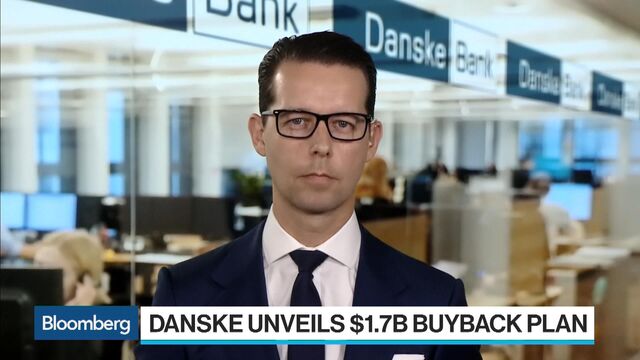Danske Hires 2,700 to Prepare It for the Age of Digital Banking
By-
Hiring is in stark contrast to Nordea, which is firing 6,000
-
Danish bank says focus is on new tasks, not cutting headcount

Danske Bank A/S hired 2,700 people last year as part of a strategy it says will help it cope with the digital age.
In an industry relying increasingly on robots, adding headcount isn’t a given.
Nordea Sinks as Bank Reveals Extra Costs From 6,000 Job Cuts
National Australia Bank to Cut 4,000 Jobs in Automation Push
Danske Chief Financial Officer Jacob Aarup-Andersen says management is building up its technology department, adding staff to areas such as the “customer experience.” Net figures show Danske had 465 more full-time workers in 2017 than the year before.

Jacob Aarup-Andersen
“We’ll continue to invest in the digital arena and therefore you will see us continue to invest in digital capabilities,” Aarup-Andersen said in an interview on Friday. “Therefore I wouldn’t expect us to suddenly see a major slowdown in our IT hirings. It is a big area for us. It is also an area where there is a lot of competition for workforce, so we do see a lot of churn. It’s just the way it is.”
Danske isn’t planning any “dramatic changes” to its headcount, he said.
Record Results
The bank is hiring after making more money than ever before in 2017. It plans to spend billions on yet another share buyback program and is raising its dividend target. And all that in a country that boasts the world record in negative interest rates (which are supposed to be bad for banks).
After more than half a decade of life below zero, Danske has been transformed into a profit machine, with almost 90 percent of analysts who rate the stock now advising clients to hold on to their shares or buy even more.
Aarup-Andersen says negative rates have provided “a very strong backdrop on the credit-quality side.” Low borrowing costs have also saved Danske lots of money when it comes to funding its operations, he said. But on the cost side, Danske has lost money because of its decision not to pass negative rates on to retail depositors. So are negative rates good or bad for banks?
“We do think negatives rates are negative in the longer term for the economy,” Aarup-Andersen said. “We also believe it obviously gives us a P&L impact, but it also has the benefit of making it easier for our customers to deliver on their promises.”
Best Result Ever
Danske delivered its best full-year result ever on Friday. Net profit reached 20.9 billion kroner ($3.5 billion), which was the high end of the bank’s target range for the year. Back in November, Danske said it expected to land somewhere between 19-21 billion kroner. For this year, it’s targeting a range of 18-20 billion kroner.
One of the reasons the forecast for 2018 is lower than the bank’s profit in 2017 is the interest rate outlook, Aarup-Andersen said. “When we look into 2018 it’s fair to say that interest rates is one of the big unknowns in terms of the speed of change that we’ll see,” he said in an interview with Bloomberg Television’s Francine Lacqua.
“We’re obviously confident in our outlook. We think that’s a fair reflection going into the year,” he said.
Rewarding Shareholders
The bank is planning to buy back 10 billion kroner in shares. Because its “capital position is very strong,” Danske says it’s now targeting a dividend payout ratio of 40-60 percent, compared with 40-50 percent previously. After buying back a total of 23 billion kroner of its stock since 2015, the bank is also proposing a dividend of 10 kroner per share for 2017, or 45 percent of net profit.
The news helped Danske’s shares open more than 3 percent higher in Copenhagen, putting it at the top of Bloomberg’s index of European financial stocks. By mid-morning, it was trading up about 1.5 percent.

With negative rates forcing the financial industry to rethink its approach to making money, many banks have shifted their focus to asset management, which also tends to generate smaller capital requirements than traditional lending. Aarup-Andersen says Danske has devoted a lot of manpower to ensuring it’s getting enough fees to make up for the lack of interest income.
“We’ve spent the last couple of years focusing the model much more on being much more a fee-driven model and we’ve been very clear on that,” Aarup-Andersen said. “We’ve been investing in a number of the fee-driven businesses. Capital markets is a good example where we’ve been adding capacity.”
Danske 4Q Numbers:
- Net interest income was 6.04 billion kroner, compared with 5.79 billion kroner a year earlier
- Net fee income reached 4.22 billion kroner, up from 4.03 billion kroner
- Net income was 5.45 billion kroner, versus 5.41 billion kroner at the end of 2016
- Danske had a CET1 ratio of 17.6 percent of risk-weighted assets at the end of 2017, versus 16.3 percent a year earlier
- Return on equity in 2017 reached 13.6 percent, versus the bank’s target of at least 12.5 percent. Danske says that because it’s now met its goal, it’s introducing a new long-term target to be among “the top three” Nordic banks in ROE
- Capital markets fees were 4.37 billion kroner, from 3.45 billion kroner a year earlier
